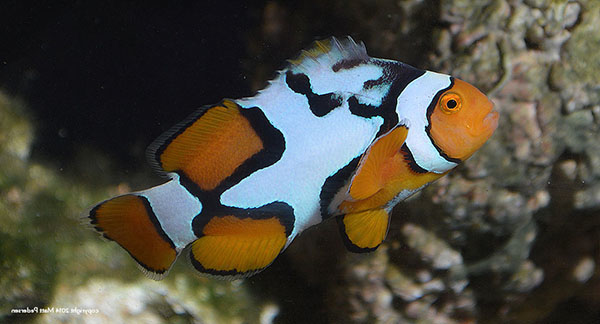Designer Clownfish are more popular than ever; over the summer of 2014 I’ve spent endless hours researching both the genetic and hybrid forms of designer clownfishes out there. I spoke on the topics of genetics, hybrids, and geographic variants at the 2014 Marine Breeder’s Workshop, and that led to three articles on the same topics, the first two of which are published this month in the “Wild Clowns” issue of CORAL Magazine.
One of my goals for these articles is to attempt to bring order to chaos, tracing the origins, pointing out the synonyms, and when possible, introducing you all to some of the newest and rarest designer forms that are only now coming to light or will come available in the years ahead.
One of the most show-stopping new forms, that most Reef Builders readers will come to lust over, is the Nebula Percula, from Bali Aquarich.
It’s probably been a year that a new type of designer Percula Clownfish started showing up in clownfish-centric discuss, but the genetics behind it may have been much longer. Over the past couple years, designer fish with “dirty” markings have occasionally been found among genetic variants including the Snowflake and Fancy Ocellaris, and the Picasso Percula by various breeders, particularly Sustainable Aquatics and Proaquatix. Recently, a trickle of Bali Aquarich’s Nebula Percula started coming into the US, and it’s about time we show you that this isn’t just another made-up name slapped on a fish for marketing purposes.

The fish I’m showing here are two lower-grade Nebula Perculas shipped to me a few weeks back. They do indeed show the dirty, fuzzy markings seen in other genetic forms…but why are we not simply calling this a Picasso Percula?

Well, if the language translations are correct, Wen-Ping Su informs us that the Nebula Percula was actually founded off a single wild fish showing extremely complex spotting and twisting of the midstripe, combined with areas of hazy, smudgy edges, in stark contrast to the normally crisp borders of most every clownfish stripe known to date.
 Regarding this unique blurring of the stripes, the term “Smudgy” has stuck for the phenotype that’s found in multiple fish variants. What we do know is that, in the case of the Nebula Percula, there must be some genetic basis for the trait, otherwise we wouldn’t be seeing them produced. That said, it remains to be seen whether the Nebula Percula is a combination of a “smudgy gene” PLUS a “picasso gene”, or is a new gene altogether.
Regarding this unique blurring of the stripes, the term “Smudgy” has stuck for the phenotype that’s found in multiple fish variants. What we do know is that, in the case of the Nebula Percula, there must be some genetic basis for the trait, otherwise we wouldn’t be seeing them produced. That said, it remains to be seen whether the Nebula Percula is a combination of a “smudgy gene” PLUS a “picasso gene”, or is a new gene altogether.
Over the years, my opinions on “designer clownfishes” has changed dramatically, and that change is the direct result of information and knowledge. I’d encourage anyone interested in designer clownfishes to keep their eyes on Reef Builders for new variants as they come to light, and to pick up a copy of the latest CORAL Magazine, which I believe will become a very necessary clownfish reference library update (until we see the next definitive book published).

Disclaimer – While I’ve been a Reef Builders contributor for years, I am also one of the Sr. Editors of CORAL Magazine and author of the articles referenced



